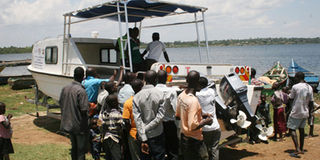Salvation for pregnant women

Residents examine a water ambulance donated by US ambassador to Kenya Robert Godec after it arrived at Usenge beach in Siaya County last year. Qualified people are shying away from seeking jobs in the county government due to run-down infrastructure, a report says. PHOTO | JACOB OWITI |
What you need to know:
- “Residents have been having problems accessing health care for too long. If the boats are utilised properly, maternal and child mortality would be reduced by 55 per cent,” he said.
- But residents are demanding that the county governments provide better services, including construction of hospitals on the islands.
- The boats, which were donated by American government through its Aids Population and Health Integrated (Aphiaplus) programme, are meant to vastly improve access to health care in Siaya, Busia and Homa Bay counties.
Pregnant women living on islands in counties bordering Lake Victoria have been losing their babies due to lack of transport to take them to hospitals on the mainland.
Many others in Siaya, Homa Bay and Busia counties have given birth in boats on their way to hospital as they do not offer emergency services and only operate for 12 hours.
One year ago, Ms Nelly Aketch from Oyamo Island lost her baby on her way to Bondo District Hospital. She had waited for a boat for half a day though her labour pains had begun.
TOO CONFUSED
“The baby was due and I only had my 12-year-old sister with me. The boat steward was too confused and shy to come near me. I had to deliver the baby by myself and it took a long time,” Ms Aketch said sadly.
On arrival at the hospital, nurses told her the baby girl had suffocated and died.
Ms Anjeline Okello faced the same predicament eight months ago but was lucky to deliver her baby just before the boat docked at Usenge in Siaya County.
She was also headed for Bondo District Hospital.
“I joined other passengers at Mahanga Beach at midday after I felt some pains in my back. I did not know I would deliver so soon but the women on the boat helped me,” said the mother of baby Kelvin Otieno.
According to Mageta Island Assistant Chief Cornelius Awuondo, tragedies like Ms Okello’s were common as lake transport was unreliable.
“Births and other emergencies often turn tragic due to delays in getting to the people hospitals,” he said.
The recent launch of three ambulance motorboats by the US Ambassador to Kenya, Mr Robert Godec, will have brought a huge sigh of relief from the residents.
The boats, which were donated by American government through its Aids Population and Health Integrated (Aphiaplus) programme, are meant to vastly improve access to health care in Siaya, Busia and Homa Bay counties.
But residents are demanding that the county governments provide better services, including construction of hospitals on the islands.
“We are happy that we now have an ambulance to get us to hospital. But this is not enough as without support from the county, the ambulance might lack fuel. We also need facilities where we can be attended to before emergencies arise,” said Ms Aketch.
County governments in the region have identified inaccessibility of health services as the highest contributor to high maternal and child mortality rate and HIV and Aids prevalence.
Siaya Governor Cornel Rasanga, who flagged off the boats, said his government was putting introducing measures to improve health care access and delivery.
“Residents have been having problems accessing health care for too long. If the boats are utilised properly, maternal and child mortality would be reduced by 55 per cent,” he said.
He promised to increase budgetary allocations to equip hospitals. “Ambulances alone are not enough without drugs and medical professionals,” he said.
Mr Rasanga was accompanied by Homa Bay Deputy Governor Hamilton Orata and his Busia counterpart Wangalwa Kizito.
The leaders said they intended to reverse poor health indicators in the region with special focus on the high maternal and child mortality, malnutrition and high HIV and Aids prevalence rates.
A recent survey indicates that cases of infant mortality in the region stand at 117 per 1,000 live births against 310 per 1,000 nationally.





